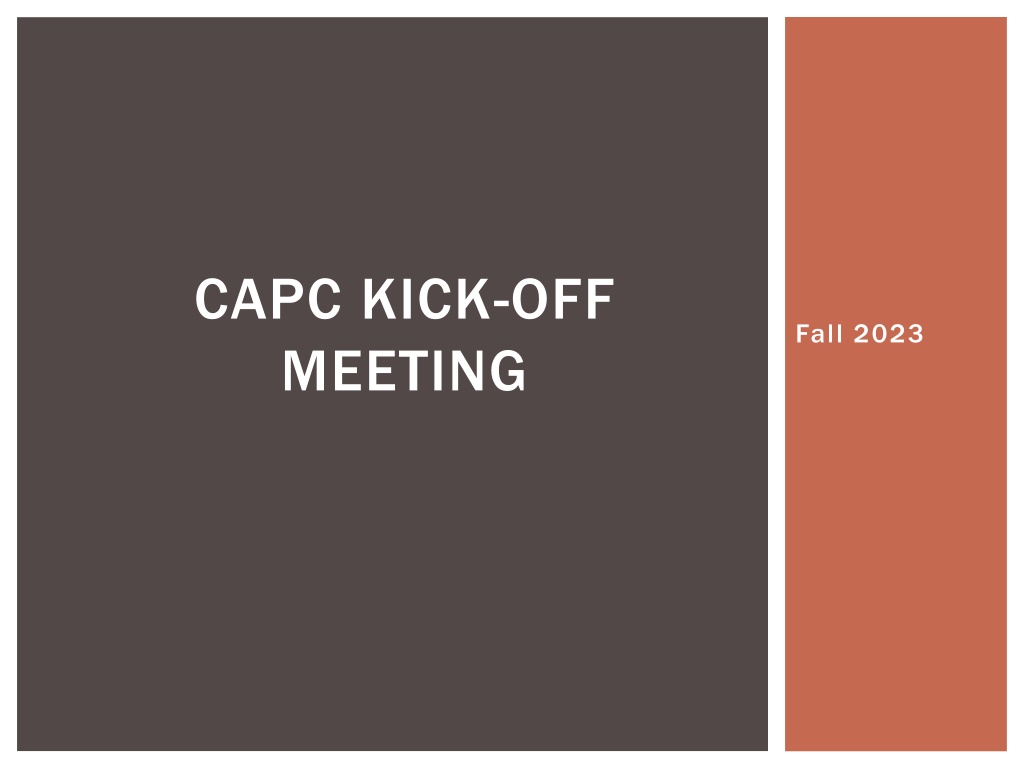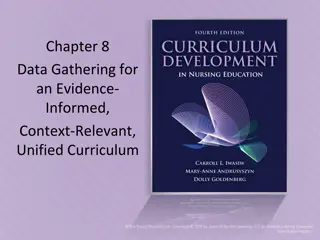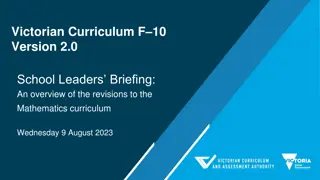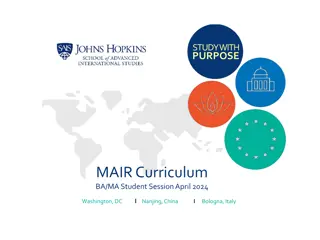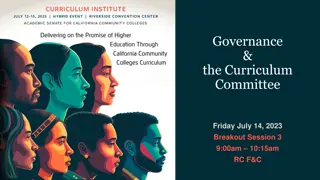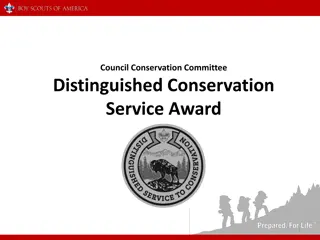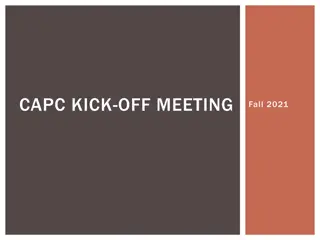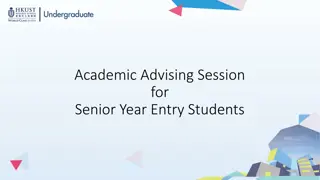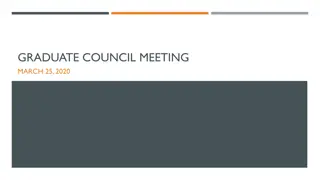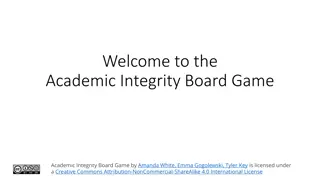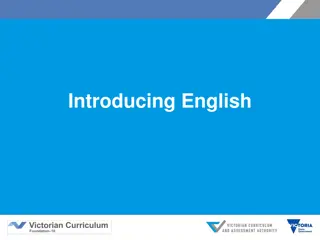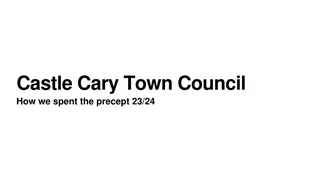Understanding CAPC: Curriculum and Academic Policies Council Overview
CAPC, the Curriculum and Academic Policies Council, is a faculty legislative body responsible for recommending changes to academic policies and curriculum. Governed by bylaws, CAPC conducts elections, engages in decision-making processes, and has various committees and subcommittees dedicated to specific areas of academic focus. Learn more about how CAPC works and why its role is crucial in shaping academic programs.
Download Presentation

Please find below an Image/Link to download the presentation.
The content on the website is provided AS IS for your information and personal use only. It may not be sold, licensed, or shared on other websites without obtaining consent from the author. Download presentation by click this link. If you encounter any issues during the download, it is possible that the publisher has removed the file from their server.
E N D
Presentation Transcript
CAPC KICK-OFF MEETING Fall 2023
WHAT IS CAPC? CAPC is the Curriculum and Academic Policies Council CAPC is a faculty legislative body, the only such body with authority to recommend changes to (or creation of) the curriculum and/or academic policies CAPC is a recommending body; the Provost has sole authority other the curriculum and academic policies
WHY ARE WE HERE? because CAPC is the curricular body mandated by the CBA (Article 31 section E): There shall be a curriculum committee at each University, which shall be selected as determined by the FACULTY, but which may include at least one (1) administrator if designated by the President.
WHY ARE WE HERE? CAPC is governed by a set of bylaws that lay out the committee structure, duties, and processes that comprise the foundation of CAPC s work APSCUF runs elections for CAPC, which involve both at-large and department-specific members. Members are elected to do the following: participate in CAPC s decision-making processes around curriculum and academic policies, through the committee structure report back to their constituencies (department, college, etc.) about CAPC processes and actions department-specific members also provide support and guidance for colleagues developing curriculum proposals for submission to CAPC, e.g., about learning outcomes, CIM, etc.
HOW CAPC WORKS Participation in decision-making processes happens through: work on committees and subcommittees monthly CAPC General Assembly meeting where decisions are made on the proposals sent up by the committees
HOW CAPC WORKS Several CAPC committees have subcommittees: General Education Distributives Diverse Communities Ethics Interdisciplinary Speaking Emphasis Writing Emphasis
HOW CAPC WORKS Several CAPC Committees have subcommittees: Academic Review Course Review and Revalidation Low Enrollment Advisory Course Delivery Program Review Undergraduate Programs Culture Cluster
2023-24 CAPC EXECUTIVE COMMITTEE Chair Chair: Susan Johnston, Anthropology & Sociology Vice Chair Vice Chair: Rodney Mader, English Secretary Secretary: Francis Atuahene, Public Policy & Administration Undergraduate Programs Undergraduate Programs: Josh Auld, Associate Provost for Academic Affairs Undergraduate Policies Undergraduate Policies: Elizabeth Pfaffle, Applied Music Graduate Programs & Policies Graduate Programs & Policies: Lisa Calvano, Dean of the Graduate School General Education General Education: Karen Mitchell, Psychology Academic Review Academic Review: Jade Burris, Early & Middle Grades Education CAPC Support CAPC Support: Patrick Richard, Academic Affairs
HOW CAPC WORKS You should know your assigned committee(s) by now. If not, they can be found at the CAPC website Committees should meet on a regular schedule Your service on CAPC includes attendance at both Assembly meetings Assembly meetings and committee meetings committee meetings If you cannot attend, your proxy should attend on your behalf applies to both Assembly applies to both Assembly and committee meetings meetings The bylaws require all CAPC members to have a proxy identified and communicated to the CAPC Secretary in advance of meetings committee
HOW CAPC WORKS Article 4.A.1.c. Each CAPC member will submit to the CAPC Secretary written notification of that member s proxy. In the case of members elected by constituency, the proxy must be selected from the same constituency. Proxies should be identified no later than the first scheduled Assembly in the fall. Should the proxy require an alternate, the proxy or member should notify the Recording Secretary in writing prior to the Assembly in which the alternate is to serve.
HOW CAPC WORKS Your service on CAPC also includes the following: preparing for committee and sub-committee meetings by reading in advance and reflecting on all documents on the agenda preparing for CAPC Assembly by reviewing in advance those items on the agenda that did not come from your committee ensuring that you are fully acquainted with the current requirements for course and program proposals, including the relevant policies (syllabi, course evaluations, etc.)
HOW CAPC WORKS Part of your duty as a CAPC member is to represent your constituency, and this means reporting back to them about CAPC Assembly and its procedures, debates, and recommendations. This includes CAPC decisions about courses, programs, or policies that may have impact on your department (or your other constituencies), whether or not they originated in your department or college You should also let your constituents know when an item of theirs appears on the Assembly agenda and remind them that they are invited to attend the relevant assembly meeting they are invited to attend the relevant assembly meeting to respond to questions that might arise
HOW CAPC WORKS Your duties as a CAPC member also include representing your constituency s views: In assembly floor discussions about motions under consideration In the Updates from Departments portion of the agenda (under Continuing Business); this is a good place to let us know about items under discussion in your departments (or other constituencies)
HOW CAPC WORKS NOTE: When a committee has sent an item forward for the Assembly agenda, it is with that committee s support (unless explicitly stated otherwise). Similarly, when a department chair, dean, or CAPC officer signs off on a proposal in CIM, it indicates support (not simply acknowledgment) That said, deans may assume they are leaving curricular decisions to the departments and to CAPC, and are only approving the availability of resources and other non-curricular issues In point of fact, a decision at each step in the review process is to recommend recommend (or not recommend not recommend), since final approval rests with the Provost
HOW CAPC WORKS Motions passed by CAPC are submitted to the Provost for approval. The Provost makes the ultimate decisions regarding curriculum and academic policy. There is a procedure for dialogue in the event that the Provost does not approve CAPC recommendations. This is rare, however. The Provost s approvals are circulated by Patrick Richard and are available on the CAPC website.
CAPC WEBSITE https://www.wcupa.edu/viceProvost/capc/
REMEMBER In summary: CAPC is a contractually mandated representative body that gives faculty significant control over the curriculum. At WCU, we have it a lot better than many other places, including some in PASSHE As CAPC representatives, we have an obligation to responsibly carry out our mandate on behalf of the faculty and departments we represent
CIM: COURSE INVENTORY MANAGEMENT https://www.wcupa.edu/viceProvost/capc/
HOW CIM WORKS Note: Email notifications (approval requests & notifications) come from Patrick Richard Note: Email notifications (approval requests & notifications) come from Patrick Richard
CIM REIMPLEMENTATION Anticipated Timeframe Form Form Program (edit existing or propose new program) Policy (edit existing or propose new policy) Course (edit existing or propose new course) Expected Availability Expected Availability End of September 2023 End of September 2023 Middle of November 2023 Proposal approval timeline adopted last year will be followed See CAPC website (Proposals page) For time-sensitive proposals, preparers are encouraged to work with relevant CAPC committee chairs to ensure proposal readiness for submission when forms are available
PROPOSAL TIMELINES 2023-24 Program changes that expand student options: must be approved by December 2023 assembly Program changes that restrict student options: deadline was May 2023 for Fall 2024 Course proposals for Summer or Fall 2024 implementation must be recommended by February 23, 2024 in order to be available for registration Course changes for Winter or Spring 2024 that can go through Circulation (e.g., additional modality) must complete that process by the start of October registration; see the email detailing the specific process to be used while the CIM forms are offline
CIM OPEN LABS We typically provide two in-person opportunities early in the semester to help preparers with curriculum or CIM questions as they work to enter proposals in CIM. This semester we are doing them a bit later due to the gradual re-implementation of CIM. Wednesday, Sept. 27, 1-3, Philips Lower-Level Conference Room Friday, Oct. 27, 12-2, via Zoom (link will be sent out by Patrick Richard)
RECENT UPDATES & EFFORTS FOR THIS YEAR
TRANSITION TO BANNER (RAMPORTAL) FROM MYWCU
Banner Project Why? PASSHE Move to a singular Student Information System (SIS) Facilitate Academic Sharing Two instances of Banner STP: Shared Technology Platform (all other PASSHE Schools) WCU Instance How is WCU approaching this project Implement Innovate Integrate Inspire to maximize institutional flexibility to prioritize student success for the future. WCU business processes to transform the user experience. people, processes, information, and systems to create alignment, cohesion, and efficiency. collaboration and student- centered services across campus.
Instruction Mode Changes Goal: Create greater clarity regarding how fully online courses are offered, particularly regarding whether the instruction is offered in real-time (synchronously) or more self-paced (asynchronously). myWCU Code Code RamPortal Instruction Mode Definition Face-to-face instruction Students attend in-person Distance learning is up to 15% of total course In Person P IP Combination of face-to-face and distance Distance may be synchronous or asynchronous Distance learning 15-79% of total course Blended BL & WE BL Combination of face-to-face and distance Distance may be synchronous or asynchronous Distance learning 80-99% of total course Distance Majority O8 DM Distance learning 100% of total course A portion of the course is synchronous Distance Synchronous OL DS Distance learning 100% of total course The entire course is asynchronous Distance Asynchronous OL DA A mix of face-to-face and distance instruction Students have option to participate in class using either modality through semester Not in myWCU Multi-Modal* MM *CAPC is working on framework for Multi-Modal course review. Anticipated for Fall 2025.
Shifting Instruction Modes This current instruction modes (P, BL, WE, O8, OL) will continue to be scheduled through summer 2024. The new instruction modes (IP, BL, DM, DA, DS) will be scheduled starting fall 2024. CIM, the system utilized by CAPC to manage curricular changes, will be updated to link to banner effective Fall 2023. Therefore, the new instruction modes will show in CIM this year. If a department is updating the instruction mode on a course in CIM, they will select from the new list of instruction modes. Multi-Modal won t be available for utilization until Fall 2025.
Single-Component Classes WCU Currently utilizes multi-component courses (i.e., courses with two elements such as Lecture & Lab, or Lecture & Discussion). Example: BIO 110 has a lecture & lab component In Banner we ll move to having unique courses for each component Example: BIO 110 = Lecture, BIO 110L = Lab These courses are then setup as corequisites to ensure students enroll in both.
Shift to single-component Worked with impacted departments to move multi- component courses to single-component in the catalog. Effective for fall 2024 WCU Component Values Lecture: Remains the 3-digit catalog number (e.g., BIO 110) Laboratory: L will be placed at end of number (e.g., BIO 110L) Discussion: D will be placed at end of number (e.g., BIO 110D) Seminar: S will be placed at end of number (e.g., BIO 110S)
Grading Each grade value has its own logic for 1) if grade is calculated in GPA; 2) if the grade counts toward earned credit. Introducing characters to grades to distinguish between: standard grades, remedial grades, forgiven grades, academic renewal grade Example: Grade of "A" Calculate in GPA = Yes Earn Credit = Yes Example Grade of "A*" for remedial courses Calculate in GPA = Yes Earn Credit = No Introduces a non-graded component (i.e., labs, discussions, etc.)
Examples of Grades Quality Points Earned CreditCount in Level Grade Mode GPA DR A 4.000 Yes Yes Standard DR E 1.670 Yes No Covid-19 GR B+ 3.330 Yes Yes Standard GR P 0.000 Yes No Pass/Fail GR A-** 3.670 No Yes Accelerated TR Credit UG C 2.000 Yes Yes Standard UG C* 2.000 No Yes Remedial UG D^ 1.000 Yes No Academic Forgiveness UG D^^ 1.00 Yes No Academic Renewal DR GR UG NC 0.000 No No Non-Graded Component
More to Come. Stay Informed. EMAIL: SIS@WCUPA.EDU WEBSITE: WCUPA.EDU/RAMPOR TAL
CAPC COMMITTEE UPDATES & PRIORITIES
SUMMER UPDATES DE Training Task Force Recommendations 2022 New, modular OFD (Online Faculty Development) program developed by ODLI, implemented this summer 4 required modules & 3 additional elective modules Self-paced, asynchronous (on D2L) Academic Policies Audit Provost s office and CAPC reviewed the scope of existing policies (on CAPC website and/or in CIM) Eventual goal is to organize, update, and ensure academic policies are current and consistently available in a single location Academic Review Committee re-envisioning (discussed below)
PRIORITIES AND EFFORTS THIS YEAR Academic Programs & Policies Academic Programs & Policies Work toward a smooth process as CIM is reimplemented over the fall, supporting programs as they prepare proposals Complete process of ensuring undergraduate major and minor programs comply with existing PASSHE policy and local definitions Continue development and review of a comprehensive Graduate Academic Programs Policy Continue work to update and organize other Graduate and Undergraduate academic policies
PRIORITIES & EFFORTS THIS YEAR General Education and General Requirements General Education and General Requirements Complete the W revalidation process Complete Capstone assignment & ePortfolio implementations Recommend for approval new J Goal & SLOs resulting from the work of the Diverse Communities Task Force Continue work to create vibrant faculty learning communities around each of the components Reminder: Gen Ed courses that come through the proposal review process, regardless of reason, will be reviewed under the current GE goal and SLO structure
UPDATES & EFFORTS THIS YEAR Academic Review Academic Review Committee s structure and duties were reviewed this summer and refocused going forward in response to changing circumstances and needs Examples: using past reports to inform future work (e.g., Program Review subcommittee, Low Enrollment Advisory) utilizing a reactivated Course Delivery subcommittee to provide expertise on course modality questions refocusing the Course Review and Revalidation process on key elements of compliance with the catalog
